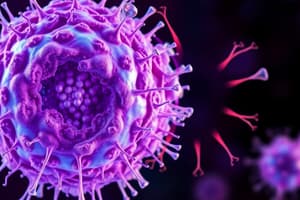Podcast
Questions and Answers
Explain the purpose of a laboratory room and describe its key features.
Explain the purpose of a laboratory room and describe its key features.
A laboratory room is a controlled environment designed for scientific research, experiments, analysis, and measurement. It is equipped with specialized instruments, tools, and safety equipment to ensure accurate and safe experimentation.
What is the primary difference in DNA structure between prokaryotic and eukaryotic cells?
What is the primary difference in DNA structure between prokaryotic and eukaryotic cells?
Prokaryotic cells have circular DNA without histones, while eukaryotic cells have linear DNA associated with histones.
Why is it important to wear safety goggles in a lab? Provide two reasons.
Why is it important to wear safety goggles in a lab? Provide two reasons.
Safety goggles protect your eyes from harmful chemicals, heated materials, and flying debris that could cause serious injury.
Describe the difference in size between prokaryotic and eukaryotic cells.
Describe the difference in size between prokaryotic and eukaryotic cells.
What are two essential pieces of safety equipment that should always be readily accessible in a laboratory room?
What are two essential pieces of safety equipment that should always be readily accessible in a laboratory room?
Describe the difference between prokaryotic and eukaryotic cells, focusing on their cellular structure.
Describe the difference between prokaryotic and eukaryotic cells, focusing on their cellular structure.
What type of cell division do prokaryotic cells use? And what types of cell division do eukaryotic cells use?
What type of cell division do prokaryotic cells use? And what types of cell division do eukaryotic cells use?
Why is it crucial to keep a clean and organized work area in a laboratory?
Why is it crucial to keep a clean and organized work area in a laboratory?
What are the key differences in organelles found in prokaryotic and eukaryotic cells?
What are the key differences in organelles found in prokaryotic and eukaryotic cells?
List three specific lab safety rules that are crucial for protecting yourself and others.
List three specific lab safety rules that are crucial for protecting yourself and others.
Provide examples of prokaryotic organisms.
Provide examples of prokaryotic organisms.
What are the defining features of eukaryotic organisms?
What are the defining features of eukaryotic organisms?
What is the primary purpose of safety signs in a laboratory, and how do they contribute to a safe environment?
What is the primary purpose of safety signs in a laboratory, and how do they contribute to a safe environment?
Explain why it is important to know the location of emergency equipment like a fire extinguisher and eyewash station.
Explain why it is important to know the location of emergency equipment like a fire extinguisher and eyewash station.
What is the study called that focuses on microscopic organisms?
What is the study called that focuses on microscopic organisms?
What is the main difference between a Petri dish and a laboratory glass?
What is the main difference between a Petri dish and a laboratory glass?
Describe the difference between free-living bacteria and parasitic bacteria.
Describe the difference between free-living bacteria and parasitic bacteria.
How are bacteria classified, specifically considering their morphology and aggregation?
How are bacteria classified, specifically considering their morphology and aggregation?
Give one example of a prokaryotic organism and one example of a eukaryotic organism.
Give one example of a prokaryotic organism and one example of a eukaryotic organism.
Why is understanding bacterial aggregation important in microbiology?
Why is understanding bacterial aggregation important in microbiology?
Flashcards
Laboratory Room
Laboratory Room
A controlled environment for scientific research and experiments.
Preventive Measures
Preventive Measures
Guidelines to ensure safety in the laboratory.
Safety Goggles
Safety Goggles
Protective eyewear to shield eyes from hazards.
Fire Extinguisher Location
Fire Extinguisher Location
Signup and view all the flashcards
Prokaryotic Cells
Prokaryotic Cells
Signup and view all the flashcards
Eukaryotic Cells
Eukaryotic Cells
Signup and view all the flashcards
Nucleoid
Nucleoid
Signup and view all the flashcards
Lab Area Cleanliness
Lab Area Cleanliness
Signup and view all the flashcards
Hand Hygiene
Hand Hygiene
Signup and view all the flashcards
No Eating or Drinking
No Eating or Drinking
Signup and view all the flashcards
Nucleus
Nucleus
Signup and view all the flashcards
DNA Structure
DNA Structure
Signup and view all the flashcards
Cell Size
Cell Size
Signup and view all the flashcards
Cell Division
Cell Division
Signup and view all the flashcards
Ribosomes
Ribosomes
Signup and view all the flashcards
Cell Wall Composition
Cell Wall Composition
Signup and view all the flashcards
Bacteria
Bacteria
Signup and view all the flashcards
Bacterial Morphology
Bacterial Morphology
Signup and view all the flashcards
Study Notes
Laboratory Room
- A laboratory room is a controlled area for scientific research, experiments, analysis, and measurement.
- It's equipped with specialized tools, instruments, and safety equipment to ensure accurate and safe experiments.
Laboratory Instruments
- Bunsen burner: Used for heating samples.
- Bacterial loop: Used for transferring bacterial samples.
- Evaporating dish: Used for evaporating liquids.
- Wire brush: Used for cleaning laboratory equipment.
- Crucible and cover: Used for high-temperature heating and containing materials.
- 24-well plate: Used for performing multiple small-scale experiments.
- Mortar and pestle: Used for grinding substances.
- Test-tube rack: Used for storing and organizing test tubes.
- Lab burner: Used for heating in experiments.
- Forceps: Used for handling small objects, often in biology or chemistry labs.
- Wash bottle: Used for rinsing equipment or applying solutions.
- Pipet: Used for precise transfer of liquids in smaller quantities.
- Graduated cylinder: Used for measuring liquid volumes.
- Volumetric flask: Used for accurate preparation of solutions.
- Conical flask: Used for receiving and mixing substances.
- Watch glass: Used to cover beakers or as a platform for reactions.
- Funnel: Used to pour liquids into containers with narrow openings.
- Dropper: Used for dispensing small amounts of liquids.
- Petri dish: A shallow dish used for growing microorganisms or conducting experiments on them.
Laboratory Safety Precautions
- Listen to/read instructions carefully before beginning any experiment.
- Wear safety goggles to protect eyes.
- Report any spills or accidents promptly.
- Wash hands thoroughly after handling chemicals.
- Keep hands away from your face during experiments.
- Tie back long hair.
- Keep work area uncluttered (avoid unnecessary materials).
- Know lab safety equipment (fire extinguishers, first aid).
- Do not eat or drink in the lab.
- Wear appropriate clothing (no loose sleeves).
- Use appropriate lab equipment for the task and materials being used.
Microbiology
- Microbiology: Study of microscopic organisms.
- Bacteria: Single-celled organisms; may be independent (free-living) or dependent (parasitic).
- Bacterial cell structures: Include chromosomal DNA, ribosomes, plasmids, inclusions, capsule, flagellum.
- Bacterial forms: Coccus, coccobacillus, vibrio, bacillus, spirillum, spirochete.
- Different forms have specific arrangements in the cell.
Microorganism Classification
- Prokaryotes: Simple cells, lack membrane-bound organelles, circular DNA (not in a nucleus).
- Includes bacteria and archaea.
- Eukaryotes: Complex cells, have membrane-bound organelles, linear DNA in a nucleus.
- Includes protists, fungi, animals, and plants.
- Prokaryotes are smaller than eukaryotes.
- Different types of bacteria have various shapes, including coccus, bacillus, spirillum and their variations, such as diplococcus, streptococci, etc..
Studying That Suits You
Use AI to generate personalized quizzes and flashcards to suit your learning preferences.




